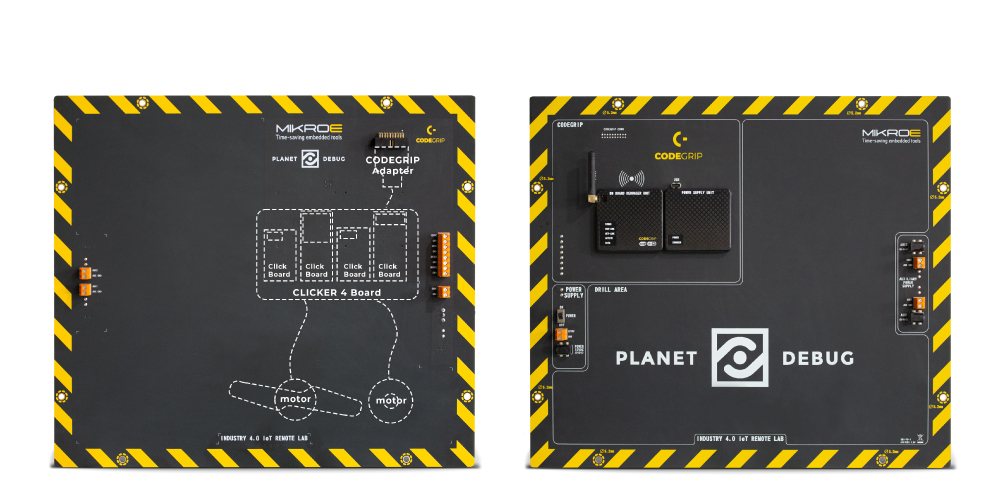OFF
GO LOCAL
| Company | Stock | Price |
|---|---|---|

MIKROE-6637
2200 g
Status:
Planet Debug Backplane 1 UNI CODEGRIP unit is a hardware panel that serves as the physical mounting surface for embedded setups used with MIKROE’s Planet Debug remote development service. It features an integrated UNI CODEGRIP WiFi debugger, input connectors for 12VDC power, and multiple regulated output voltages (1.8V, 3.3V, and 5V), all derived from a single user-supplied source. A clearly marked DRILL AREA allows for safe mechanical modifications such as attaching motors or sensors, while the clean front layout supports flexible setup arrangements. This board acts as the foundation on which embedded projects are physically installed and remotely accessed, monitored, and controlled in real time via the NECTO Studio IDE. Ideal for education, hardware testing labs, and remote development workflows, the Planet Debug Backplane 1 UNI CODEGRIP unit enables engineers to work with real hardware through the Planet Debug service - from anywhere in the world.
NOTE: The Planet Debug Backplane 1 UNI CODEGRIP unit includes both the CODEGRIP SSL and CODEGRIP WiFi licenses FOR FREE, enabling secure SSL-encrypted communication and full wireless programming/debugging capabilities right out of the box. For more information about these licenses, please refer to their official product pages.
This product is no longer in stock
Availability date:
OFF
| Company | Stock | Price |
|---|---|---|

The Planet Debug Backplane 1 UNI CODEGRIP unit is a dedicated hardware panel designed for mounting embedded setups that will be used within the Planet Debug service - MIKROE’s Industry 4.0 IoT Remote Lab for real-time remote embedded development. Installed on the Planet Debug frame, this backplane serves as the physical base for all configurations displayed and controlled remotely through the Planet Debug platform.

Planet Debug itself enables engineers to interact with real hardware - development boards, sensors, actuators, and displays - as if they were physically in the lab, all from anywhere in the world. Each setup includes an actual development board and a live video camera, combined with a UNI CODEGRIP WiFi debugger (this particular backplane) that provides SSL-secured remote access. Through the NECTO Studio IDE, users can stream a live video feed directly from the lab and observe in real time how their code affects the physical device - whether it’s an LED blinking, a sensor value changing, or a display being refreshed. Unlike software simulators that only emulate behavior, Planet Debug gives users direct access to real hardware and peripherals, ensuring accurate feedback and reliable test results.
The Planet Debug Backplane 1 UNI CODEGRIP unit is the mounting surface where these hardware setups are placed and operated. On the back side of the board, it features an integrated UNI CODEGRIP WiFi debugger along with a Power Supply section on the left-hand side. This section includes a power switch and two 12VDC input connectors: one standard terminal and one barrel jack. These 12VDC inputs, which the user must provide, are essential for powering the system. Opposite, on the right-hand side, is a section reserved for Auxiliary power supply inputs. The central portion of the back side is dominated by a clearly marked DRILL AREA, which is the only area where the board may be mechanically modified - for example, drilled to mount motors or other hardware components required by the setup.
The front side of the backplane is kept largely clean to allow flexibility in arranging different parts of the setup. On the left, a few connectors are available for auxiliary power needs, while the right-hand side contains a set of output connectors delivering various voltage levels - 1.8V, 3.3V, and 5V. These output voltages are derived from the main 12VDC power input supplied by the user, providing the necessary operating levels for a wide range of embedded devices. The top-right corner of the board is designated for mounting development boards such as the Clicker 4 or others. It is important to align any mechanical modifications with the DRILL AREA on the back side, as this is the only zone permitted for drilling on both the front and back, ensuring safe and precise hardware integration.
At the very bottom of the backplane, a printed label identifies it as the official board intended for use with the Planet Debug service. This label confirms its role as an integral part of MIKROE’s remote development infrastructure, serving as the physical foundation for setups that are accessed, monitored, and controlled remotely through the Planet Debug platform.
| Parameter | Value |
|---|---|
| Input Voltage | 12V DC (via terminal connector or barrel jack) |
| Output Voltages | 1.8V / 3.3V / 5V (regulated from 12V input) |
| Power Supply Control | On-board power switch |
| Integrated Debugger | UNI CODEGRIP WiFi (SSL-secured, remote debugging and programming) |
| Wireless Connectivity | WiFi, secured SSL channel |
| Mechanical Features | Designated DRILL AREA for mounting, development board mounting slot (top-right corner) |